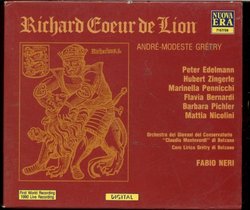| All Artists: André Ernest Modeste Grétry, Fabio Neri, Gretry Chorus, Monteverdi Orchestra Title: Gretry: Richard Coeur de Lion. (Barbara Pichler, Hubert Zingerle, Peter Edelmann, Gretry Chorus, Monteverdi Orchestra, Fabio Neri) 1990 Live Recording Members Wishing: 0 Total Copies: 0 Label: Nuova Era Genre: Classical Style: Number of Discs: 2 SwapaCD Credits: 2 |
Search - André Ernest Modeste Grétry, Fabio Neri, Gretry Chorus :: Gretry: Richard Coeur de Lion. (Barbara Pichler, Hubert Zingerle, Peter Edelmann, Gretry Chorus, Monteverdi Orchestra, Fabio Neri) 1990 Live Recording
 | André Ernest Modeste Grétry, Fabio Neri, Gretry Chorus Gretry: Richard Coeur de Lion. (Barbara Pichler, Hubert Zingerle, Peter Edelmann, Gretry Chorus, Monteverdi Orchestra, Fabio Neri) 1990 Live Recording Genre: Classical From Wikipedia - Richard Coeur-de-lion (Richard the Lionheart) is an opéra comique, described as a comédie mise en musique, by the Belgian composer André Grétry. The French text was by Michel-Jean Sedai... more » |
Larger Image |
CD Details
Synopsis
Product Description
From Wikipedia - Richard Coeur-de-lion (Richard the Lionheart) is an opéra comique, described as a comédie mise en musique, by the Belgian composer André Grétry. The French text was by Michel-Jean Sedaine. The work is generally recognised as Grétry's masterpiece and one of the most important French opéras comiques.[1] It is based on a legend about King Richard I of England's captivity in Austria and his rescue by the troubadour Blondel de Nesle. t was first performed in three acts by the Comédie-Italienne at the first Salle Favart in Paris on 21 October 1784. It was given in a revised four-act version at Fontainebleau on 25 October 1785. The opera reached the United Kingdom in 1786 and Boston, USA in 1797. It was immensely popular and was still being played in France at the end of the 19th century.
A translated semi-opera version of Sedaine's work Richard Coeur de lion was written by John Burgoyne with music by Thomas Linley the elder for the Drury Lane Theatre where it was very successful in 1788. Richard Coeur-de-lion played an important role in the development of opéra comique in its treatment of a serious, historical subject. It was also one of the first rescue operas. Significantly, one of the chief characters in the most famous rescue opera of all, Beethoven's Fidelio, is called Florestan, though he is the prisoner not the jailor. Grétry attempted to imitate Medieval music in Blondel's song Une fièvre brûlante and his example would be followed by composers of the Romantic era. (Beethoven wrote a set of piano variations on the song, WoO. 72.) He also used the same melody as a recurring theme, a technique developed by later composers of opéra comique such as Méhul and Cherubini. Through them it would influence the German tradition of Weber and Wagner.
A translated semi-opera version of Sedaine's work Richard Coeur de lion was written by John Burgoyne with music by Thomas Linley the elder for the Drury Lane Theatre where it was very successful in 1788. Richard Coeur-de-lion played an important role in the development of opéra comique in its treatment of a serious, historical subject. It was also one of the first rescue operas. Significantly, one of the chief characters in the most famous rescue opera of all, Beethoven's Fidelio, is called Florestan, though he is the prisoner not the jailor. Grétry attempted to imitate Medieval music in Blondel's song Une fièvre brûlante and his example would be followed by composers of the Romantic era. (Beethoven wrote a set of piano variations on the song, WoO. 72.) He also used the same melody as a recurring theme, a technique developed by later composers of opéra comique such as Méhul and Cherubini. Through them it would influence the German tradition of Weber and Wagner.
